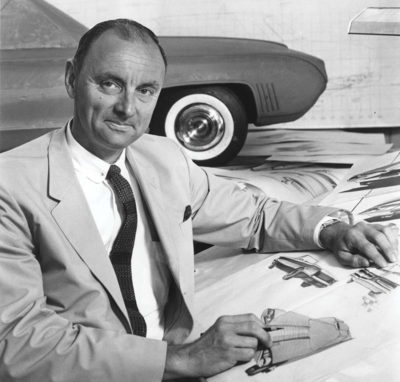Elwood Engel Managed Styling of Mopar Muscle Cars

Muscle car designer Elwood Engel came up via the GM styling studio system, but made a mark at Ford and Chrysler. He was one of a few budding designers accepted in a work-study program, and one of even fewer to get through it. George W. Walker and Joe Oros, whom he met in 1939, did the same.
During World War II, Engel was a map maker in the U.S. Army. He stayed in touch with Oros who, after the war, attended the Cleveland Insitute of Art, where George W. Walker had studied. Oros then went to work at an industrial design firm that Walker had started, and he recommended hiring Engel.
Walker’s firm had Nash and Baker-Raulang, a body company, as clients. Oros did automotive work for both firms, and Engel designed alarm clocks, tractors, shoes and appliances. He was brought into a Ford project when ex-Studebaker man Dick Caleal showed Walker a design for a “Shoebox” Ford.
In 1947, Walker won a Ford contract and ended his association with Nash. After that, Engel and Oros focused on car design. Ford ran a competition to seek alternatives to an in-house design by Bob Gregorie. Walker, Engel and Oros made a full-scale version of a model at Ford’s Dearborn plant and incorporated their ideas, along with some of Gregorie’s, to create the ’49 Ford.
- Edson Armi’s The Art of American Car Design (Pennsylvania State University, 1988), said of Engel’s contribution to the groundbreaking car, “In the end, the exceptional appearance of the Ford may owe less to Loewy’s team and to designers like Walker and Gregorie than to experienced modelers at Ford, to Walker’s assistants Oros and Engel and to the collective design process.”
Engel was a people person and Oros wasn’t. Elwood loved playing practical jokes and telling risque stories and generally goofing around. But the two men were very close. Oros was best man at Engel’s wedding to Marguerite Imboden. In 1955, when Walker was hired to be in charge of Ford’s design studio, he brought Oros and Engel with him. Engel was put in charge of Lincoln and Mercury, while Oros was in charge of Ford car and truck designs.
Engel and Oros came up with competing designs for the 1958 T-bird and Oros’ four-seat car got the nod. However, the “Stiletto” roadster that Engel’s team created caught the eye of Ford President Robert S. McNamara, who saw the Engel team’s clay model and asked them to add rear doors. He then decided that it could be sold as a “Lincoln Continental.” That car became the basis for the 1961 Lincoln Continental, rather than a new two-door, two-passenger T-bird.
Just after the Continental came out, Walker turned 65 and retired. Everyone thought that Engel or Oros would be his replacement, but Ford unexpectedly picked Eugene Bordinat. Engel started looking for a new job.
Engel’s friend Walker had political power at Detroit’s Recess Club. Chrysler president Lynn Townsend was one of his connections. At Chrysler, styling director Virgil Exner’s Valiant design had rubbed Townsend the wrong way. In addition, Exner had suffered a heart attack and his absence set off some infighting led by his lieutenant Bill Schmidt. A meeting that Walker set up between Engel and Townsend led to the former getting hired as Chrysler’s vice president of design. Engel started working at Highland Park in November 1961.

Like Harley Earl, Engel was good at delegating design work to teams of stylists. He would then fine-tune their clay models with his touches. According to Mike Lamm’s interviews with Chrysler designers Bill Brownlie and Carl Cameron, this was far different from the Exner approach where the designers were expected to style cars the way that the boss would have done it.
Exner continued to have an office at Chrysler after Engel was hired as his boss, but Bornlie told Lamm “I’m sure his heart wasn’t in it and every day he came in must have been torture.” The other designers liked Engel though.
Co-workers said Engel had an uncanny eye for the “commercial viability” of designs. He was also known to pinch pennies with the “boys” in the modeling studio. “He wanted to go out and play and be a big shot,” Brownlie said. “He’d walk into a studio and, if things were going well, you wouldn’t see him again for days. If things weren’t going well, he’d be in there absolutely raising hell.”
Engel oversaw the design and development of the famous 1963 Chrysler Turbine cars (of which 50 were loaned out to 203 families for public testing). The two-door hardtop is said to look very much like his original design for the ‘61 stiletto T-bird that ultimately became the ’61 Lincoln Continental. He used the fibreglass model of this car to illustrate his design preferences to the Chrysler designers and emphasize to them that tailfins were out, but the design didn’t really point to the future at Chrysler. It was just something unto itself.
Chrysler vets like designer Dave Cummins believe cars like the ’65 Plymouth Fury sum up what Engel was about. He liked crisp fender lines and a lot of gimmicks like slab sides, wrapover roofs, hidden headlights and airfoil grilles. He liked to adorn cars with lots of brightwork and badges. In the mid-‘60s, he liked the boxy look with razor-tip fenders that characterized the Continental from 1961-1968. After 1968, he championed a smooth, rounded “airplane fuselage” look that Bill Brownlie and Richard Stas began with the ’68 Charger.
Some of the noteworthy Chrysler Corp. cars that Engel played a role in designing include the Gen II ’63 Valiant, the ’68 Charger, the ’69 Dodge Polara, the ’70 Challenger and Barracuda, the ’72 Satellite and the ’72 Imperial, but he approved all of the Chrysler, Dodge and Plymouth designs of those years. He appeared at least twice on the cover of Automotive Industries, a trade magazine.
Engel actually retired from Chrysler in 1973, but he continued to work as a consultant until some management changes that took place in June 1974 changed things. Cars as late as the ’76 Imperial continued to reflect his design legacy. On June 24, 1986, Elwood Engel died of cancer.





















